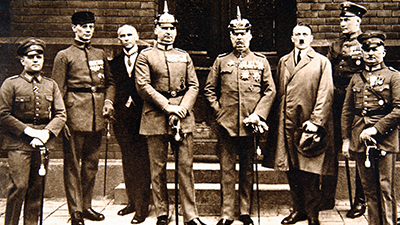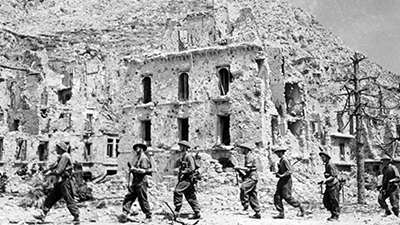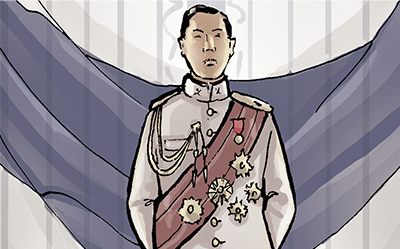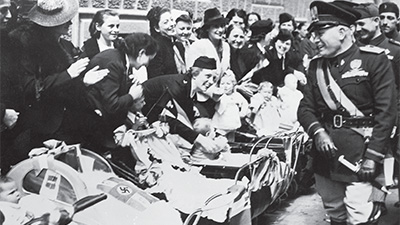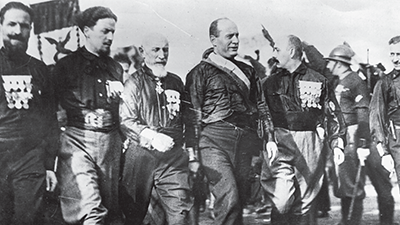Causes of World War II
Teacher Resources
Driving Question: In what ways did the causes of World War II lead to global conflict, and how did its consequences reshape the world order?
The rise of fascism and the failure of internationalism shattered a fragile peace that followed the First World War. The Second World War quickly engulfed the world. There has never been a war on the same scale. More people died in the conflict than in any other war in history. It transformed global power, devastating the economies and populations of many industrial empires. But what led to the Second World War and was this war simply a continuation of thirty years of conflict that started in 1914?
Learning Objectives
- Explain the causes and consequences of World War II.
- Use the historical reasoning process of causation to understand the causes and consequences of World War II.
- Analyze primary source documents to evaluate how governments conducted war and how people responded to these methods after 1900.
- Use a graphic biography to support, extend, or challenge the overarching narratives of this period.
Vocab Terms:
- alliance
- antisemitism
- casualty
- eugenics
- nuclear
- party platform
- racial superiority
Opener: Causes of World War II
To teach this lesson step, refer to page 3 of the Lesson 7.6 Teaching Guide.
Looking for teacher tips on how to run this activity? Check out Political Party Platform Activity in the Community Forum.
Let’s party! And by party, we mean study political party platforms, of course!
What Is Fascism?
To teach this lesson step, refer to page 5 of the Lesson 7.6 Teaching Guide.
The growth in popularity of fascist ideologies was an important factor in the coming of the Second World War and some of history’s greatest atrocities.
-
Guiding Questions
-
Before you watch
Preview the questions below, and then review the transcript.
While you watch
Look for answers to these questions:
- Where does the word “fascism” come from?
- Why does the video argue that defining fascism as a form of political behavior is an important distinction?
- What are some of the methods that fascists use to gain power?
- Why was internationalism a threat to the fascist agenda?
- Why is total war the only kind of war for fascists?
- How are authoritarianism and populism different from fascism?
After you watch
Respond to the following questions:
- To what extent does this video explain the causes and consequences of World War II?
- Why do you think the rise of fascism has historically caused conflict? What is it about fascism that makes it likely to create violence?
- This video deals with some heavy topics. But one of its messages is that some of the problems presented by fascism in the twentieth century remain unresolved in the twenty-first century. Do you see any of those problems in current events? If so, where and how? If not, make a case that fascism is not an appropriate term to use to describe world events today.
Key Ideas
Who Am I?
To teach this lesson step, refer to page 6 of the Lesson 7.6 Teaching Guide.
Want some different takes on this activity? Read Who am I? Class feedback visual in the Community.
To understand who “we” are, it is imperative first to understand who “you” are.
Fascism in Germany
The scenario: Students role-play Neville Chamberlain as he made five crucial decisions about how to respond to Hitler in the lead-up to World War II:
- Anschluss (annexation of Austria), March 1938
- Munich Agreement, September 1938
- Occupation of Czechoslovakia, March 1939
- Anglo-Polish Guarantee, March 1939
- Invasion of Poland, September 1939
Prompt AI to provide students with a list of what Chamberlain knew at each step (military strength, public opinion, alliances, and Hitler’s demands). Using answers to these questions—and carefully fact-checking—students then generate arguments for and against appeasement, defending their decisions in a class discussion.
Why this is genius: By stepping into the shoes of a historical actor, students practice historical empathy. AI supports their research, but students must determine what evidence mattered most at the time.
For many, Nazi Germany is the model for our understanding of a fascist government. Initially, the Nazi party used the existing structures of government to slowly take more and more power. Antisemitism was one of the central methods used by Nazis to unite Germans around their cause.
-
Guiding Questions
-
Before you read
Preview the questions below, and then skim the article. Be sure to look at the section headings and any images.
While you read
Look for answers to these questions:
- How did Hitler exploit the Reichstag fire and how did it benefit him?
- How did Hitler make it look like he was playing by the rules as he consolidated power?
- How did the Nazi government start to take action against German Jews?
- Why were the Nuremberg Laws important in expanding Nazi attacks on German Jews?
- What did the Nazis gain from “othering” and attacking Jewish people?
After you read
Respond to the following questions:
- The Nazi party ended up taking actions that would have been completely unacceptable to many Germans when Hitler first rose to power. How do you think violence against Germany’s Jews and the consolidation of Nazi power became acceptable, or even embraced, during the 1930s?
- In this unit we see the rise of governments that have certain political characteristics. We call these characteristics fascism, authoritarianism, and totalitarianism. Using these definitions, evaluate which of these terms can appropriately be applied to this government. It may be all, some, or none:
- A totalitarian regime has a highly centralized system of government that requires strict obedience.
- An authoritarian regime focuses on the maintenance of order at the expense of personal freedom.
- A fascist regime is a government that embraces extreme nationalism, violence, and action with the goal of internal cleansing and external expansion.
Responsibility and Compassion
To teach this lesson step, refer to page 9 of the Lesson 7.6 Teaching Guide.
Looking to differentiate, modify or adapt this activity? Check out our Differentiation Guide.
Empathy allows us to, as the phrase goes, “walk in someone else’s shoes” to understand different perspectives.
Causation: World War II
To teach this lesson step, refer to page 11 of the Lesson 7.6 Teaching Guide.
Still looking to improve students’ causation skills? Support them by using the Causation Feedback Form to help them understand where they are and where they should be going with this skill.
Many factors led to World War II—evaluate these complicated causes to help make sense of how such a horrible conflict could begin.
The Second World War
To teach this lesson step, refer to page 15 of the Lesson 7.6 Teaching Guide.
Historian Trevor Getz provides a global overview of World War II, and adds an intimate dimension to the narrative by including his grandfather’s experience of the war.
-
Guiding Questions
-
Before you read
Preview the questions below, and then skim the article. Be sure to look at the section headings and any images.
While you read
Look for answers to these questions:
- When did World War II start, and why is the date somewhat unclear? What do you think is the most appropriate date to use?
- In Europe, what countries’ forces dominated the early years of World War II?
- How and why did the Soviet Union enter the Second World War?
- When and why did the United States join World War II?
- What was the big ideological difference between Britain and the Soviet Union? How did they find common ground?
- What factors shifted the tide of the war around 1942?
After you read
Respond to the following questions:
- Using evidence from this article, explain the similarities and differences in how different governments used a variety of methods to conduct war.
- How would this article be different without the inclusion of Getz’s grandfather in the narrative? Do you think you would still understand and think about the major developments in World War II in the way that you do now? Does this personal story help deepen your understanding of the war? Why or why not?
- Consider your friends and family members, and how you might weave the narrative of a grandparent, or someone whose life story you know very well, into historical events on the grandest scale. How does it help you understand and appreciate history when you successfully weave together the personal and the global, or universal?
Closer: Causes of World War II
To teach this lesson step, refer to page 16 of the Lesson 7.6 Teaching Guide.
Want to dig into more World War II resources. There are a lot of options on the World War II page.
Authoritarianism came in many forms during the World War II era. One such authoritarian leader was Plaek Phibunsongkhram, who helped unite his country by creating a dish that would become synonymous with Thai cuisine: Pad Thai.
-
Guiding Questions
-
Before you read
Preview the questions below, and then skim the comic, paying attention to things like prominent colors, shapes, and types of text and fonts. How do you know where to start and in which direction to read? What’s in the gutters (the space between panels)? Who or what is the focus of the comic?
While you read
Look for answers to these questions:
- What country did Plaek Phibunsongkhram lead, and in what years?
- What did he change the country’s name to, and what did the new name mean? Why was this name change ironic?
- What evidence does the author provide that Phibunsongkhram was an authoritarian ruler?
- Why did he create Pad Thai? Why was this creation ironic?
- What happened to Phibunsongkhram after the war?
- Authoritarian and fascist governments are all about order and following rules and governmental control. How does the artist use art and design to contribute to the message that Phibunsongkhram was an authoritarian leader?
After you read
Respond to the following questions:
- Using evidence from the graphic biography, make two connections to two different AP themes.
- How does this biography of Phibunsongkhram support, extend, or challenge what you have learned about the fascism and authoritarianism leading up to the Second World War?
Fascist Histories
To teach this lesson step, refer to page 17 of the Lesson 7.6 Teaching Guide.
Did imperialism help lead to authoritarian regimes around the world? Explore the origins of fascism in this article.
-
Guiding Questions
-
Before you read
Preview the questions below, and then skim the article. Be sure to look at the section headings and any images.
While you read
Look for answers to these questions:
- Why did people start to reject the ideology behind nineteenth-century liberalism?
- How did some nineteenth-century thinkers use science to promote racist beliefs?
- How did the end of World War I create new tensions that helped fascists come to power?
- In what ways are fascism and socialism both similar and very different?
- How did fascists use the Great Depression?
After you read
Respond to the following questions:
- How did imperialism help create some of the ideological trends that this article mentions?
- How does this article support, extend, or challenge what you have learned about fascism and authoritarianism leading up to the Second World War?
Fascism in Italy
To teach this lesson step, refer to page 18 of the Lesson 7.6 Teaching Guide.
Not all fascism in Europe looked the same. Italy had its own version led by their leader, Benito Mussolini.
-
Guiding Questions
-
Before you read
Preview the questions below, and then skim the article. Be sure to look at the section headings and any images.
While you read
Look for answers to these questions:
- How long and how many casualties did it take for Benito Mussolini’s National Fascist Party to defeat the socialists?
- What are two of the ways fascism took shape in the Po Valley?
- Why were some Italian fascists unhappy with Mussolini’s early years in power?
- How did Mussolini strengthen the power of his National Fascist Party?
- What distinguished Italian fascism from Nazism’s biological view of race?
After you read
Respond to the following questions:
- The author argues that Italian fascism never gained the level of totalitarian control the Nazis had in Germany. Why do you think Mussolini was less successful than Hitler in this respect?
- What similarities do you see between Italy’s racist ideology in Ethiopia and the ideologies behind European imperialism during the long nineteenth century?



